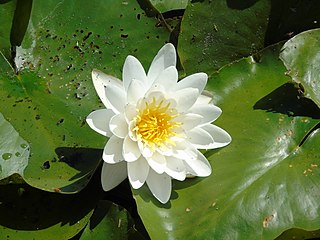
Nymphaea is a genus of hardy and tender aquatic plants in the family Nymphaeaceae. The genus has a cosmopolitan distribution. Many species are cultivated as ornamental plants, and many cultivars have been bred. Some taxa occur as introduced species where they are not native, and some are weeds. Plants of the genus are known commonly as water lilies, or waterlilies in the United Kingdom. The genus name is from the Greek νυμφαία, nymphaia and the Latin nymphaea, which means "water lily" and were inspired by the nymphs of Greek and Latin mythology.

Nymphaea odorata, also known as the American white waterlily, fragrant water-lily, beaver root, fragrant white water lily, white water lily, sweet-scented white water lily, and sweet-scented water lily, is an aquatic plant belonging to the genus Nymphaea. It can commonly be found in shallow lakes, ponds, and permanent slow moving waters throughout North America where it ranges from Central America to northern Canada. It is also reported from Brazil and Guyana.

Nymphaea nouchali, often known by its synonym Nymphaea stellata, or by common names blue lotus, star lotus, red water lily, dwarf aquarium lily, blue water lily, blue star water lily or manel flower, is a water lily of genus Nymphaea. It is native to southern and eastern parts of Asia, and is the national flower of Bangladesh and Sri Lanka. In Sanskrit it is called utpala. This species is usually considered to include the blue Egyptian lotus N. nouchali var. caerulea. In the past, taxonomic confusion has occurred, with the name Nymphaea nouchali incorrectly applied to Nymphaea pubescens.
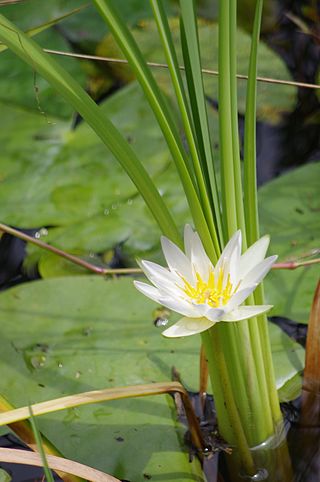
Nymphaea elegans, also known as the tropical royalblue waterlily, is a species of aquatic plants in the family Nymphaeaceae. It is native to the United States, Mexico, and the Bahamas. It has been introduced to Colombia. Additionally, it has been reported to occur in Argentina.

Nymphaea tetragona is an aquatic perennial, species of flowering plant commonly called pygmy waterlily and small white water lily, belonging to the family Nymphaeaceae.

Nymphaea gardneriana is a species of waterlily native to Cuba and tropical South America.
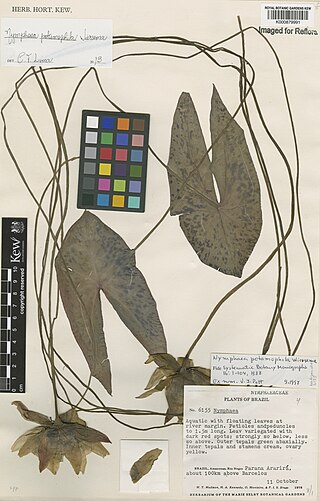
Nymphaea potamophila is a species of waterlily native to the region spanning from Venezuela to northern Brazil. Additionally, it has been reported to occur in Colombia.
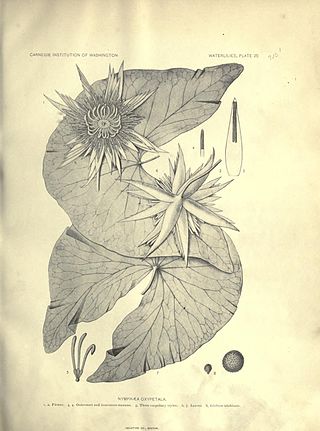
Nymphaea oxypetala is a species of waterlily native to Bolivia, Brazil, Cuba, Ecuador, Paraguay, and Venezuela. It is a remarkable species with excessively acuminate and acute sepals and petals.
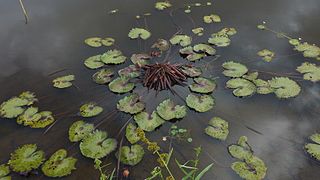
Nymphaea rudgeana is a species of waterlily native to the region spanning from Mexico to tropical South America.
Nymphaea tenuinervia is a species of waterlily native to Colombia, Guyana and Brazil.
Nymphaea belophylla is a species of waterlily native to Bolivia, Brazil and Venezuela.

Nymphaea amazonum is a species of water lily native to the region spanning from Mexico to tropical South America. It has been introduced to Bangladesh.
Nymphaea conardii is a species of waterlily native to the region spanning from Southern Mexico to tropical South America.
Nymphaea lingulata is a species of waterlily native to Bolivia, Brazil, and Paraguay.
Nymphaea novogranatensis is a species of waterlily native to Colombia, Mexico, and Venezuela.

Nymphaea × daubenyana is a species of waterlily endemic to Chad, but has been introduced to Florida, USA. It is a natural hybrid of Nymphaea micrantha and Nymphaea nouchali var. caerulea.
Nymphaea pulchella is a species of waterlily native to the regions spanning from Central and Southern Mexico to Brazil, as well as from the Bahamas to the Virgin Islands, including St. Croix.
Nuphar ulvacea is a species of rhizomatous aquatic plant native to the US-American states Alabama and Florida.
Nuphar orbiculata is a species of rhizomatous aquatic plant native to the US-American states Alabama, Florida, and Georgia.

Nymphaea subg. Hydrocallis is a subgenus of the genus Nymphaea.













